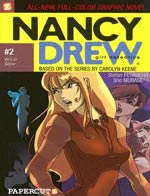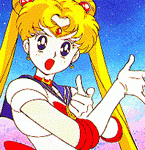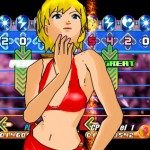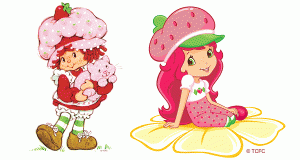 It’s devil’s advocate day here, as I try to flush out my bias and take a centrist point of view on the cartoon character facelift conundrum, exploring ‘then and now’ from a sociological perspective, with a bit more analysis from yesterday’s post on my own marketing background in terms of branding overhauls.
It’s devil’s advocate day here, as I try to flush out my bias and take a centrist point of view on the cartoon character facelift conundrum, exploring ‘then and now’ from a sociological perspective, with a bit more analysis from yesterday’s post on my own marketing background in terms of branding overhauls.
After all, Pooh Bear got a makeover. So did Mickey. Popeye. Charlie Brown. A colorized Betty Boop. Even Felix the Cat.
No one thought stick-thin Olive Oyl was an aspirational body type back then, but now she’d be called anorexic and probably shelved as a bad influence.
When talented (female) artist Sho Murase gave Nancy Drew an uber-hip manga makeover a few years back, I editorialized in the S.F. Chronicle that it would have been nice if she’d had a ‘body image’ update as well so we wouldn’t feed an entirely new generation of girls the angst-ridden “why don’t I look like that” media message. Who’s in charge of creating adventure cartoon images? Does gender make a difference in design interpretation?
Responding to this S.F. Chronicle article on Nancy Drew’s 75 year old update via graphic manga novels, I wrote: “It saddens me that the worldview for our daughters repeatedly gravitates to the doe-eyed, chest-thrusting, teeny-waisted teen as an “aspirational” illustrative icon.” I mean, c’mon…
Pop culture icons getting facelifts for ‘relevance’ is nothing new, and there’s sure nothing wrong with tossing in digital media for kid appeal and gizmos for contemporary realism in the outdated girl detective’s storyline…BUT…
…When you have a CHOICE of clothing your hero or turning her into a cleavage-baring, nearly naked “Lara Croft, Tomb Raider” (at left) style gal, I just don’t see the need to turn every digital icon into a coy princess, vampy sexpot, perky-chested beauty, nor thirdwave femme style macho-mama in clingon clothes or ‘eek, save me’ heaving chested heroine-in-peril type, ya know?
At least Nancy Drew is fully clothed…
So are we taking this media/marketing commercialization of kids too seriously?
Sometimes it seems like the sociological landscape is lurching back and forth like an untrained stick-shift driver…
 After all, just a decade ago, Sailor Moon ushered in a new era, and Powerpuff Girls exhibited a random form of equalizer in the cartoon violence dust-ups.
After all, just a decade ago, Sailor Moon ushered in a new era, and Powerpuff Girls exhibited a random form of equalizer in the cartoon violence dust-ups.
Now…fast forward to the princess posse of today with a tad more diversity but a hefty uber-dose of Disneyesque sexualization.
The counter-argument is that cartoons are exaggerations by nature, and ‘twas ever thus’ in terms of highly charged body image and role play.
One glimpse at cartoons of the past reveals stereotypes out the wazoo, some MUCH worse than today, so what’s there to get exercised about?
Sexualization? Yes, but we’ve endured a comic book jiggle-fest of half-clad superheroes like Wonder Woman, Catwoman and Superwoman and the tight-sweater huggin’ ta-tas of Archie’s Betty and Veronica for eons, so this is nothing new, right?
Gender Portrayal? Yes, but kiddie cartoons have always been chock full of stereotypes, from ‘your wish is my command’ superficial fluff (I Dream of Jeannie) to ‘bad guys’ in black cowboy hats, villains with an accent, and mice with sombreros.
Body image? Yes, but my retro reel of teeny-waisted, “X” shaped female icons reveals this regardless of the era, from the Flintstones to the Jetsons…not to mention muscle-bound Brutus and Popeye in all their testosterone/steroid six-pack splendor.
So if none of this has ever been remotely accurate in kids cartoons, how can we say these cues are seeping into kids’ psyches as hypersexualized icons?
Easy. The entire context has changed, in our surround sound environment of media and marketing proliferation.
 Ambient messages of goal-driven ‘shoulds’ imprint body ideals far beyond cartoon icons.
Ambient messages of goal-driven ‘shoulds’ imprint body ideals far beyond cartoon icons.
We see them in gaming. Avatars. Electronic paper dolls like Zwinky and StarDoll. Buffed boy and big-breasted avatars of virtual worlds.
Even the silhouettes and figures in Dance, Dance Revolution. (at left)
Seems the higher the level of human personification the more directly kids ‘see themselves’ in aspirational mirroring mode…
So as promised, I’ll now run ‘part two’ of this cartoon character facelift conundrum hearing from our own Shaping Youth body image expert, Dr. Robyn Silverman, weighing in with her views…
Enjoy! –AJ
Nip-Tuck for Strawberry Shortcake and Friends: Less Belly Fat, More Muscles, and a CellPhone
by Shaping Youth Correspondent Dr. Robyn Silverman
It appears that our yesterday’s favorite cartoon characters are getting extreme makeovers to cater to the modern tastes of today’s kids. According to the New York Times, these classic characters are being “freshened up” in order to add upward momentum to the rough sloping economy.
Apparently, the YouTube generation is interested in less belly fat and more muscles. Less “cutesy” and more streamline. Fewer calories and more cell phones. Seriously. What ever happened to nostalgia for days when we didn’t need to think about all that stuff?
Impossibly thin waists and the buff bods have been popular among fairy princesses and hulky princes, respectively, but how about the Care-bears and Little Miss Shortcake?
Strawberry Shortcake went under the figurative knife and was revealed this past Tuesday. Labeled a “fruit-forward” makeover, she was stripped of her bloomers, went on a diet (no more sweets, more fruit!), put down her cat, and picked up a cell phone.
No more freckles and of course, more pink–now her signature color in place of her customary red. She looks a lot more “little mermaid” than “strawberry sweetie” from yesteryear.
Toys and toons aimed at boys are also getting a little nip-tuck.
Teenage Mutant Ninja Turtles are losing a bit of their ‘tude and gaining more muscles. Think–turtles on steroids.
Other nostalgic characters getting a face–and body-lift? Bugs bunny, Scooby Doo, and the Care Bears, the latter getting a little lipo to lose the belly fat and eyelash extensions to enhance the eyes.
The companies are trying to appeal to the kids without going too far–attempting to stay away from the hypersexualized and increasingly violent media landscape ever-present today.
Even Mickey Mouse will be getting into the action.
Companies like Disney are giving nostalgic characters an update in an attempt to appeal to both modern kids and today’s parents—parents who are trying to protect their youngsters from seeing too much, considering the recent Miley Cyrus exposure and other young stars who are becoming less predictable and more out of control. Not to mention other brands that have gone way to far towards sexualizing the most mundane toys to appeal to Paris-Hilton-like children such as the Disney Horses–Strutz (for girls who are on the cutting edge of what’s hot in fashion)
They’re also wary of changing their brand too much or sending out items that parents don’t like as Mattel did in 1993 when they spruced up the classic Ken doll with a poorly chosen purple mesh T-shirt, leather vest, earring, and high-lighted coif. Warner Brothers made a similar marketing mistake when they revamped Bugs Bunny and Daffy Duck in 2005, full with mohawks and crazy eyes in the series “Lunatics.”
Are cartoon portrayals such a big deal?
According to numerous studies, it may be.
“the depictions about gender roles seen by children could impact and interact with both the expectations they develop about relationships and appropriate behavior, and their future life decisions. It is important to keep in mind, too, that the concern about stereotyping is not less severe because these are cartoons and not “real life.” Although this issue has not been definitely settled by research, several studies have indicated that young children accept fantasy as reality and cannot always distinguish well between the two. — Sex Roles: A Journal of Research by Thompson et al.
WEIGH IN
What do you think? Is it a good thing for these toy and cartoon companies to reflect a more streamline, beauty-oriented, techno-culture in our children’s cartoons or should they be leaving things the way they are? Are cartoons getting too sexed up for the kids or are people making too much of a big deal about the whole thing?
Please comment below! Looking forward to hearing your opinions.
Dr. Robyn Silverman (full bio here) is an ongoing Shaping Youth contributor and leading Child and Adolescent Development Specialist with a focus on character education and body/self esteem development during childhood, adolescence, and young adulthood.
Related Resources & Tips for Counter-Marketing Toxic Cues
Jump start conversations to springboard off of stereotypes:
We do a free association/word play game in our Shaping Youth media literacy where we name a character and kids say the first word that comes to mind to raise awareness on pre-judgment and such…
Here are some other ideas from Media Awareness/Canada
* Make a list of the various positive characteristics your female or male action hero should have. Some examples might be: girls and women leading others, fighting for important causes, showing bravery, caring about their female friends, and being interested in matters other attracting the attention of boys or men. Examples of positive characteristics for boys and men might be taking care of others, finding ways of solving problems other than fighting, and being sensitive and caring.
* Every heroine or hero needs a trusty sidekick. What might her/his non-stereotypical traits be?
* Draw pictures of your female/male action hero and her/his friends. Remember to incorporate characteristics that challenge conventional stereotypes.
* Create a storyboard for an episode of the new TV program. What happens in it? What action elements are different from a conventional show?
* Have each group present its work to the rest of the class.
More here in the handouts:
Stereotypes/Female Action Heroes Lesson Plan for Middle Schoolers (Media Awareness)
From Sailor Moon to Powerpuff Girls: Female Action Heroes (Media Awareness Student Handout)
Other Aligned Content:
Gender & Sexuality in Japanese Anime (theory.org.uk, David Gauntlett)
Shaping Youth Features All Girls Week, A Gender Discussion
Toys Receiving Makeovers: New, Improved, Sexy? (Feministe Fatale)
More Sexy Toy Makeovers: Lisa Frank, Trolls & Cabbage Patch Kids (Sociological Images)
Science Direct: Body Image Journal/Gender/Impact Links List
Toymakers Leave My Childhood Alone! (The-F-word.org blog)
KidTV: A Guide for the Perplexed (Steve Sailer, National Post)
Cut from the Oscars: Cartoon Characters Sins (NYTimes 2005)
Visual Credits:
Nancy Drew/Manga graphics: Sho Murase Writ in Stone/Amazon.com, Lara Croft/AarkAngel files, Sailor Moon via Media Awareness.ca.org










hey!
I made on photoshop anime myspace pictures.
take a look at them:
http://tinyurl.com/66k3ae
Thank you for your website 😉 xxoxo
I’m a huge Scooby-Doo fan, and I’m happy to see that Scooby and the gang are getting some touch ups. I have loved Scooby-Doo since I was a child, and now I’m 41. My kids are huge fans as well, so the face lifts only tell me that Scooby will be around for a little longer. Yeah!
Bin schon seit l
Sailor Moon is just great manga with unique style that we can’t found elsewhere